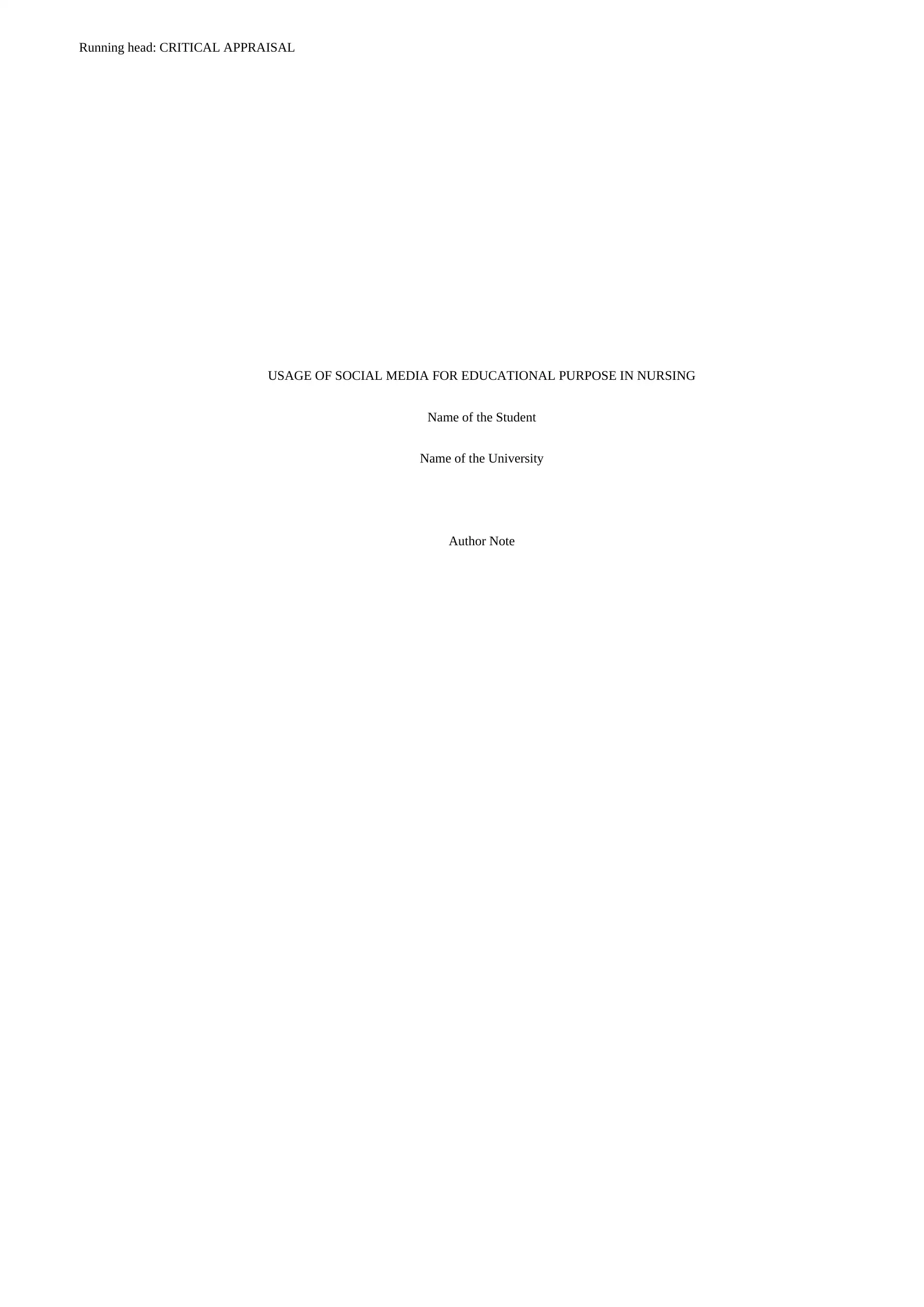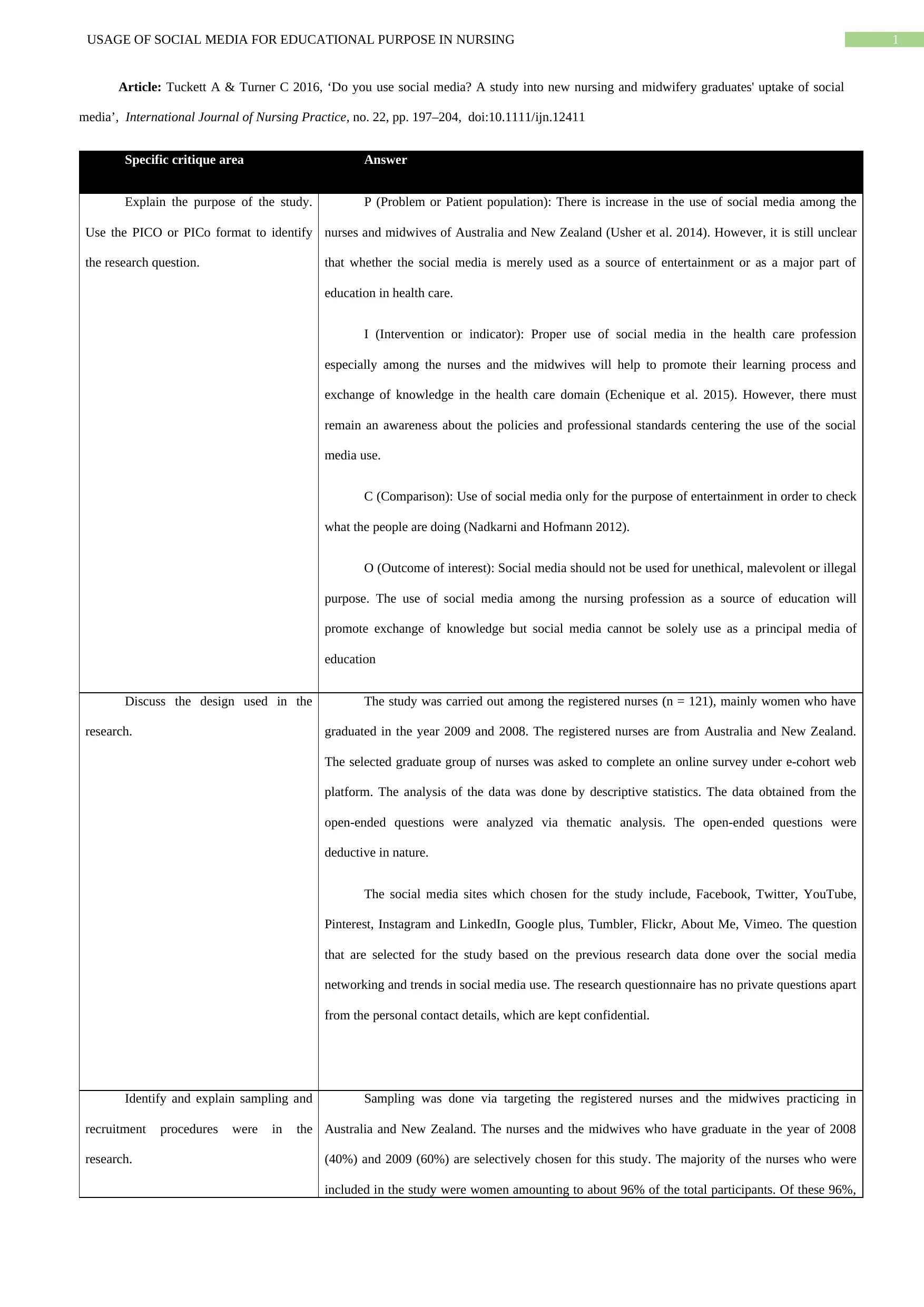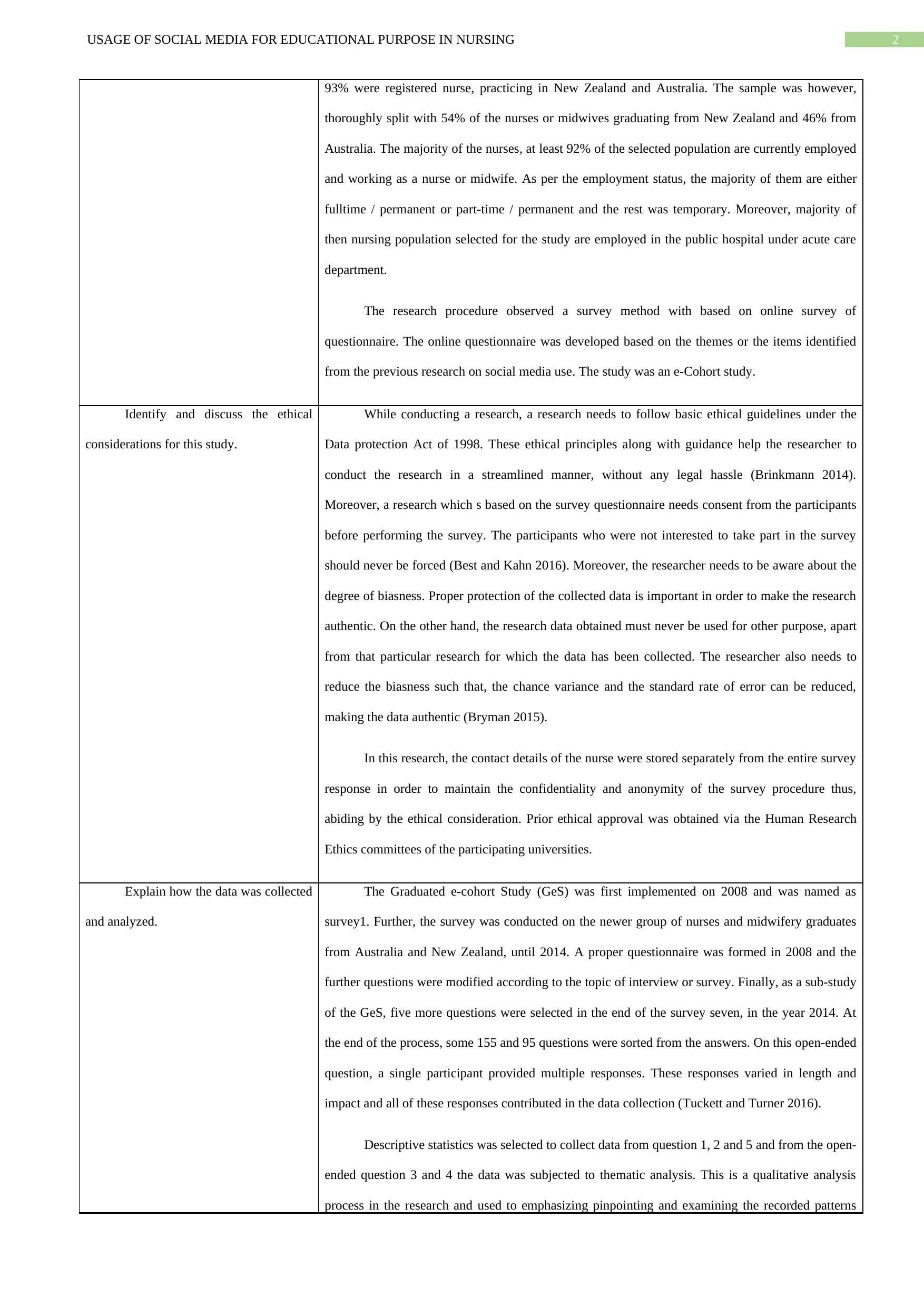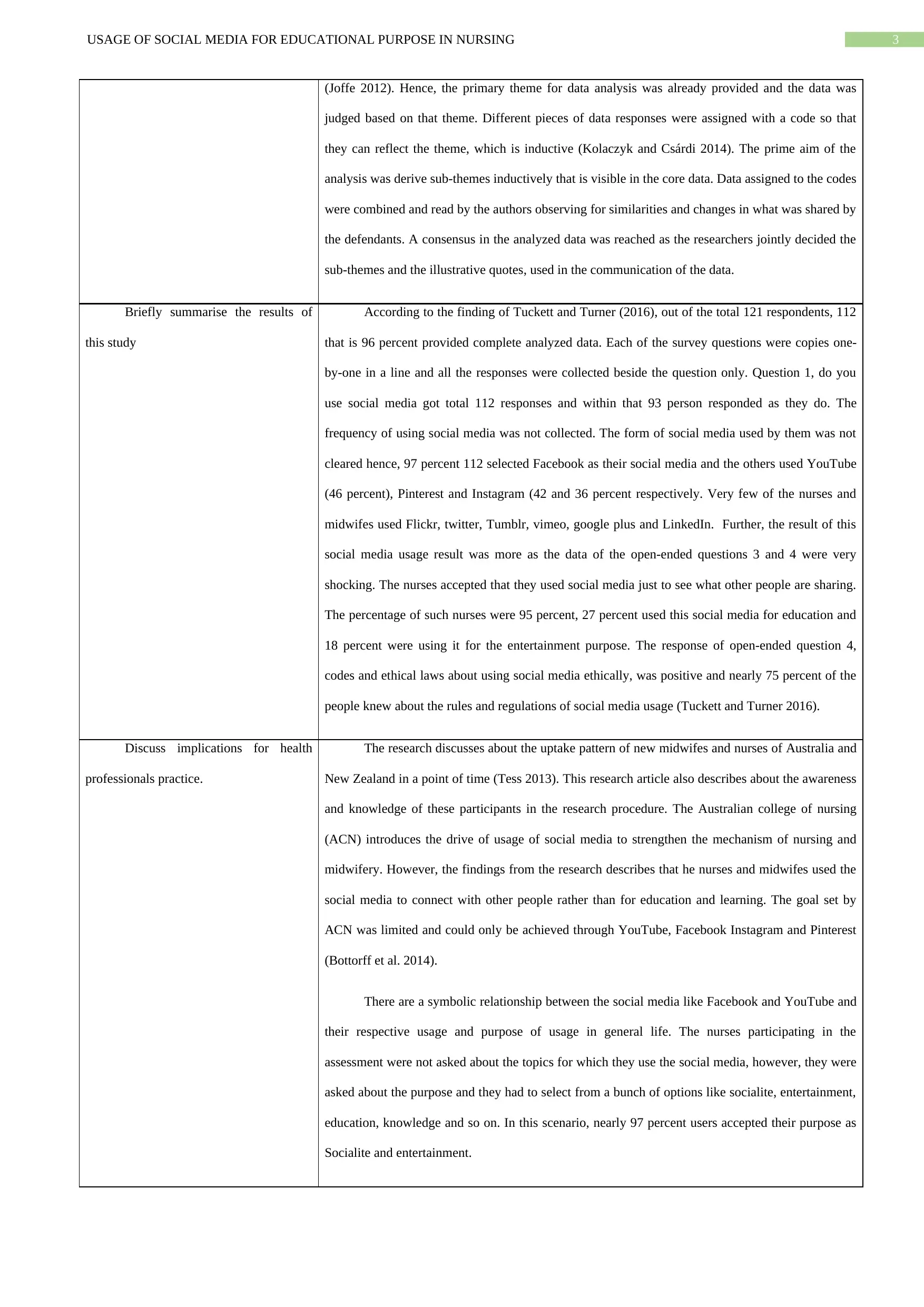Critical Appraisal of Social Media Use in Nursing Education Research
VerifiedAdded on 2020/05/04
|4
|2344
|65
Report
AI Summary
This report presents a critical appraisal of the research article by Tuckett and Turner (2016), which investigated social media usage among new nursing and midwifery graduates in Australia and New Zealand. The study employed an online survey using an e-cohort web platform and thematic analysis to examine the purpose, design, ethical considerations, data collection, and analysis methods. The findings revealed that while social media is widely used, its primary purpose is social rather than educational. The implications for health professionals' practice are discussed, highlighting the need to leverage social media more effectively for educational purposes within the nursing profession. The study emphasizes the importance of addressing the gap between social media usage and its potential for knowledge exchange and professional development in healthcare.

Running head: CRITICAL APPRAISAL
USAGE OF SOCIAL MEDIA FOR EDUCATIONAL PURPOSE IN NURSING
Name of the Student
Name of the University
Author Note
USAGE OF SOCIAL MEDIA FOR EDUCATIONAL PURPOSE IN NURSING
Name of the Student
Name of the University
Author Note
Paraphrase This Document
Need a fresh take? Get an instant paraphrase of this document with our AI Paraphraser

1USAGE OF SOCIAL MEDIA FOR EDUCATIONAL PURPOSE IN NURSING
Article: Tuckett A & Turner C 2016, ‘Do you use social media? A study into new nursing and midwifery graduates' uptake of social
media’, International Journal of Nursing Practice, no. 22, pp. 197–204, doi:10.1111/ijn.12411
Specific critique area Answer
Explain the purpose of the study.
Use the PICO or PICo format to identify
the research question.
P (Problem or Patient population): There is increase in the use of social media among the
nurses and midwives of Australia and New Zealand (Usher et al. 2014). However, it is still unclear
that whether the social media is merely used as a source of entertainment or as a major part of
education in health care.
I (Intervention or indicator): Proper use of social media in the health care profession
especially among the nurses and the midwives will help to promote their learning process and
exchange of knowledge in the health care domain (Echenique et al. 2015). However, there must
remain an awareness about the policies and professional standards centering the use of the social
media use.
C (Comparison): Use of social media only for the purpose of entertainment in order to check
what the people are doing (Nadkarni and Hofmann 2012).
O (Outcome of interest): Social media should not be used for unethical, malevolent or illegal
purpose. The use of social media among the nursing profession as a source of education will
promote exchange of knowledge but social media cannot be solely use as a principal media of
education
Discuss the design used in the
research.
The study was carried out among the registered nurses (n = 121), mainly women who have
graduated in the year 2009 and 2008. The registered nurses are from Australia and New Zealand.
The selected graduate group of nurses was asked to complete an online survey under e-cohort web
platform. The analysis of the data was done by descriptive statistics. The data obtained from the
open-ended questions were analyzed via thematic analysis. The open-ended questions were
deductive in nature.
The social media sites which chosen for the study include, Facebook, Twitter, YouTube,
Pinterest, Instagram and LinkedIn, Google plus, Tumbler, Flickr, About Me, Vimeo. The question
that are selected for the study based on the previous research data done over the social media
networking and trends in social media use. The research questionnaire has no private questions apart
from the personal contact details, which are kept confidential.
Identify and explain sampling and
recruitment procedures were in the
research.
Sampling was done via targeting the registered nurses and the midwives practicing in
Australia and New Zealand. The nurses and the midwives who have graduate in the year of 2008
(40%) and 2009 (60%) are selectively chosen for this study. The majority of the nurses who were
included in the study were women amounting to about 96% of the total participants. Of these 96%,
Article: Tuckett A & Turner C 2016, ‘Do you use social media? A study into new nursing and midwifery graduates' uptake of social
media’, International Journal of Nursing Practice, no. 22, pp. 197–204, doi:10.1111/ijn.12411
Specific critique area Answer
Explain the purpose of the study.
Use the PICO or PICo format to identify
the research question.
P (Problem or Patient population): There is increase in the use of social media among the
nurses and midwives of Australia and New Zealand (Usher et al. 2014). However, it is still unclear
that whether the social media is merely used as a source of entertainment or as a major part of
education in health care.
I (Intervention or indicator): Proper use of social media in the health care profession
especially among the nurses and the midwives will help to promote their learning process and
exchange of knowledge in the health care domain (Echenique et al. 2015). However, there must
remain an awareness about the policies and professional standards centering the use of the social
media use.
C (Comparison): Use of social media only for the purpose of entertainment in order to check
what the people are doing (Nadkarni and Hofmann 2012).
O (Outcome of interest): Social media should not be used for unethical, malevolent or illegal
purpose. The use of social media among the nursing profession as a source of education will
promote exchange of knowledge but social media cannot be solely use as a principal media of
education
Discuss the design used in the
research.
The study was carried out among the registered nurses (n = 121), mainly women who have
graduated in the year 2009 and 2008. The registered nurses are from Australia and New Zealand.
The selected graduate group of nurses was asked to complete an online survey under e-cohort web
platform. The analysis of the data was done by descriptive statistics. The data obtained from the
open-ended questions were analyzed via thematic analysis. The open-ended questions were
deductive in nature.
The social media sites which chosen for the study include, Facebook, Twitter, YouTube,
Pinterest, Instagram and LinkedIn, Google plus, Tumbler, Flickr, About Me, Vimeo. The question
that are selected for the study based on the previous research data done over the social media
networking and trends in social media use. The research questionnaire has no private questions apart
from the personal contact details, which are kept confidential.
Identify and explain sampling and
recruitment procedures were in the
research.
Sampling was done via targeting the registered nurses and the midwives practicing in
Australia and New Zealand. The nurses and the midwives who have graduate in the year of 2008
(40%) and 2009 (60%) are selectively chosen for this study. The majority of the nurses who were
included in the study were women amounting to about 96% of the total participants. Of these 96%,

2USAGE OF SOCIAL MEDIA FOR EDUCATIONAL PURPOSE IN NURSING
93% were registered nurse, practicing in New Zealand and Australia. The sample was however,
thoroughly split with 54% of the nurses or midwives graduating from New Zealand and 46% from
Australia. The majority of the nurses, at least 92% of the selected population are currently employed
and working as a nurse or midwife. As per the employment status, the majority of them are either
fulltime / permanent or part-time / permanent and the rest was temporary. Moreover, majority of
then nursing population selected for the study are employed in the public hospital under acute care
department.
The research procedure observed a survey method with based on online survey of
questionnaire. The online questionnaire was developed based on the themes or the items identified
from the previous research on social media use. The study was an e-Cohort study.
Identify and discuss the ethical
considerations for this study.
While conducting a research, a research needs to follow basic ethical guidelines under the
Data protection Act of 1998. These ethical principles along with guidance help the researcher to
conduct the research in a streamlined manner, without any legal hassle (Brinkmann 2014).
Moreover, a research which s based on the survey questionnaire needs consent from the participants
before performing the survey. The participants who were not interested to take part in the survey
should never be forced (Best and Kahn 2016). Moreover, the researcher needs to be aware about the
degree of biasness. Proper protection of the collected data is important in order to make the research
authentic. On the other hand, the research data obtained must never be used for other purpose, apart
from that particular research for which the data has been collected. The researcher also needs to
reduce the biasness such that, the chance variance and the standard rate of error can be reduced,
making the data authentic (Bryman 2015).
In this research, the contact details of the nurse were stored separately from the entire survey
response in order to maintain the confidentiality and anonymity of the survey procedure thus,
abiding by the ethical consideration. Prior ethical approval was obtained via the Human Research
Ethics committees of the participating universities.
Explain how the data was collected
and analyzed.
The Graduated e-cohort Study (GeS) was first implemented on 2008 and was named as
survey1. Further, the survey was conducted on the newer group of nurses and midwifery graduates
from Australia and New Zealand, until 2014. A proper questionnaire was formed in 2008 and the
further questions were modified according to the topic of interview or survey. Finally, as a sub-study
of the GeS, five more questions were selected in the end of the survey seven, in the year 2014. At
the end of the process, some 155 and 95 questions were sorted from the answers. On this open-ended
question, a single participant provided multiple responses. These responses varied in length and
impact and all of these responses contributed in the data collection (Tuckett and Turner 2016).
Descriptive statistics was selected to collect data from question 1, 2 and 5 and from the open-
ended question 3 and 4 the data was subjected to thematic analysis. This is a qualitative analysis
process in the research and used to emphasizing pinpointing and examining the recorded patterns
93% were registered nurse, practicing in New Zealand and Australia. The sample was however,
thoroughly split with 54% of the nurses or midwives graduating from New Zealand and 46% from
Australia. The majority of the nurses, at least 92% of the selected population are currently employed
and working as a nurse or midwife. As per the employment status, the majority of them are either
fulltime / permanent or part-time / permanent and the rest was temporary. Moreover, majority of
then nursing population selected for the study are employed in the public hospital under acute care
department.
The research procedure observed a survey method with based on online survey of
questionnaire. The online questionnaire was developed based on the themes or the items identified
from the previous research on social media use. The study was an e-Cohort study.
Identify and discuss the ethical
considerations for this study.
While conducting a research, a research needs to follow basic ethical guidelines under the
Data protection Act of 1998. These ethical principles along with guidance help the researcher to
conduct the research in a streamlined manner, without any legal hassle (Brinkmann 2014).
Moreover, a research which s based on the survey questionnaire needs consent from the participants
before performing the survey. The participants who were not interested to take part in the survey
should never be forced (Best and Kahn 2016). Moreover, the researcher needs to be aware about the
degree of biasness. Proper protection of the collected data is important in order to make the research
authentic. On the other hand, the research data obtained must never be used for other purpose, apart
from that particular research for which the data has been collected. The researcher also needs to
reduce the biasness such that, the chance variance and the standard rate of error can be reduced,
making the data authentic (Bryman 2015).
In this research, the contact details of the nurse were stored separately from the entire survey
response in order to maintain the confidentiality and anonymity of the survey procedure thus,
abiding by the ethical consideration. Prior ethical approval was obtained via the Human Research
Ethics committees of the participating universities.
Explain how the data was collected
and analyzed.
The Graduated e-cohort Study (GeS) was first implemented on 2008 and was named as
survey1. Further, the survey was conducted on the newer group of nurses and midwifery graduates
from Australia and New Zealand, until 2014. A proper questionnaire was formed in 2008 and the
further questions were modified according to the topic of interview or survey. Finally, as a sub-study
of the GeS, five more questions were selected in the end of the survey seven, in the year 2014. At
the end of the process, some 155 and 95 questions were sorted from the answers. On this open-ended
question, a single participant provided multiple responses. These responses varied in length and
impact and all of these responses contributed in the data collection (Tuckett and Turner 2016).
Descriptive statistics was selected to collect data from question 1, 2 and 5 and from the open-
ended question 3 and 4 the data was subjected to thematic analysis. This is a qualitative analysis
process in the research and used to emphasizing pinpointing and examining the recorded patterns
⊘ This is a preview!⊘
Do you want full access?
Subscribe today to unlock all pages.

Trusted by 1+ million students worldwide

3USAGE OF SOCIAL MEDIA FOR EDUCATIONAL PURPOSE IN NURSING
(Joffe 2012). Hence, the primary theme for data analysis was already provided and the data was
judged based on that theme. Different pieces of data responses were assigned with a code so that
they can reflect the theme, which is inductive (Kolaczyk and Csárdi 2014). The prime aim of the
analysis was derive sub-themes inductively that is visible in the core data. Data assigned to the codes
were combined and read by the authors observing for similarities and changes in what was shared by
the defendants. A consensus in the analyzed data was reached as the researchers jointly decided the
sub-themes and the illustrative quotes, used in the communication of the data.
Briefly summarise the results of
this study
According to the finding of Tuckett and Turner (2016), out of the total 121 respondents, 112
that is 96 percent provided complete analyzed data. Each of the survey questions were copies one-
by-one in a line and all the responses were collected beside the question only. Question 1, do you
use social media got total 112 responses and within that 93 person responded as they do. The
frequency of using social media was not collected. The form of social media used by them was not
cleared hence, 97 percent 112 selected Facebook as their social media and the others used YouTube
(46 percent), Pinterest and Instagram (42 and 36 percent respectively. Very few of the nurses and
midwifes used Flickr, twitter, Tumblr, vimeo, google plus and LinkedIn. Further, the result of this
social media usage result was more as the data of the open-ended questions 3 and 4 were very
shocking. The nurses accepted that they used social media just to see what other people are sharing.
The percentage of such nurses were 95 percent, 27 percent used this social media for education and
18 percent were using it for the entertainment purpose. The response of open-ended question 4,
codes and ethical laws about using social media ethically, was positive and nearly 75 percent of the
people knew about the rules and regulations of social media usage (Tuckett and Turner 2016).
Discuss implications for health
professionals practice.
The research discusses about the uptake pattern of new midwifes and nurses of Australia and
New Zealand in a point of time (Tess 2013). This research article also describes about the awareness
and knowledge of these participants in the research procedure. The Australian college of nursing
(ACN) introduces the drive of usage of social media to strengthen the mechanism of nursing and
midwifery. However, the findings from the research describes that he nurses and midwifes used the
social media to connect with other people rather than for education and learning. The goal set by
ACN was limited and could only be achieved through YouTube, Facebook Instagram and Pinterest
(Bottorff et al. 2014).
There are a symbolic relationship between the social media like Facebook and YouTube and
their respective usage and purpose of usage in general life. The nurses participating in the
assessment were not asked about the topics for which they use the social media, however, they were
asked about the purpose and they had to select from a bunch of options like socialite, entertainment,
education, knowledge and so on. In this scenario, nearly 97 percent users accepted their purpose as
Socialite and entertainment.
(Joffe 2012). Hence, the primary theme for data analysis was already provided and the data was
judged based on that theme. Different pieces of data responses were assigned with a code so that
they can reflect the theme, which is inductive (Kolaczyk and Csárdi 2014). The prime aim of the
analysis was derive sub-themes inductively that is visible in the core data. Data assigned to the codes
were combined and read by the authors observing for similarities and changes in what was shared by
the defendants. A consensus in the analyzed data was reached as the researchers jointly decided the
sub-themes and the illustrative quotes, used in the communication of the data.
Briefly summarise the results of
this study
According to the finding of Tuckett and Turner (2016), out of the total 121 respondents, 112
that is 96 percent provided complete analyzed data. Each of the survey questions were copies one-
by-one in a line and all the responses were collected beside the question only. Question 1, do you
use social media got total 112 responses and within that 93 person responded as they do. The
frequency of using social media was not collected. The form of social media used by them was not
cleared hence, 97 percent 112 selected Facebook as their social media and the others used YouTube
(46 percent), Pinterest and Instagram (42 and 36 percent respectively. Very few of the nurses and
midwifes used Flickr, twitter, Tumblr, vimeo, google plus and LinkedIn. Further, the result of this
social media usage result was more as the data of the open-ended questions 3 and 4 were very
shocking. The nurses accepted that they used social media just to see what other people are sharing.
The percentage of such nurses were 95 percent, 27 percent used this social media for education and
18 percent were using it for the entertainment purpose. The response of open-ended question 4,
codes and ethical laws about using social media ethically, was positive and nearly 75 percent of the
people knew about the rules and regulations of social media usage (Tuckett and Turner 2016).
Discuss implications for health
professionals practice.
The research discusses about the uptake pattern of new midwifes and nurses of Australia and
New Zealand in a point of time (Tess 2013). This research article also describes about the awareness
and knowledge of these participants in the research procedure. The Australian college of nursing
(ACN) introduces the drive of usage of social media to strengthen the mechanism of nursing and
midwifery. However, the findings from the research describes that he nurses and midwifes used the
social media to connect with other people rather than for education and learning. The goal set by
ACN was limited and could only be achieved through YouTube, Facebook Instagram and Pinterest
(Bottorff et al. 2014).
There are a symbolic relationship between the social media like Facebook and YouTube and
their respective usage and purpose of usage in general life. The nurses participating in the
assessment were not asked about the topics for which they use the social media, however, they were
asked about the purpose and they had to select from a bunch of options like socialite, entertainment,
education, knowledge and so on. In this scenario, nearly 97 percent users accepted their purpose as
Socialite and entertainment.
1 out of 4
Related Documents
Your All-in-One AI-Powered Toolkit for Academic Success.
+13062052269
info@desklib.com
Available 24*7 on WhatsApp / Email
![[object Object]](/_next/static/media/star-bottom.7253800d.svg)
Unlock your academic potential
Copyright © 2020–2025 A2Z Services. All Rights Reserved. Developed and managed by ZUCOL.





